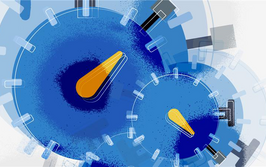The Elite Athlete Concept for Cell Therapy
How metabolic conditioning could improve cell therapy potency and persistence
Yelena Bronevetsky, James Lim | | 4 min read | Opinion

Credit: People illustrations from Shutterstock.com
Efforts to improve the performance of cell therapies inevitably focus on boosting potency through genetic engineering. The rationale is obvious; if we could just design tumor-targeting constructs and perturb exhaustion signaling pathways, surely, the resulting therapies would have the desired effect. In our view, however, there’s a more reliable and straightforward approach. Scientific evidence supports the idea that incorporating metabolic conditioning, whereby cells are exposed to oxygen and pressure levels found in tumor microenvironments, during the development and production of cell therapies will give patients the best chance at healthy outcomes.
Let’s take a step back to consider the specific improvements needed in the cell therapy space. First, existing therapies targeting cancer tend to work well in just a small fraction of patients and we need this success rate to be higher (1); lack of response to a cell therapy should be a rare event. Second, current therapies have been predominantly approved for treatment against blood cancer, but with liquid malignancies representing just 10 percent of cancers, there is a pressing need to expand the utility of cell therapies to solid tumors.
To address both of these challenges (improving efficacy rates and addressing a broader range of cancers), we should develop cell therapies with greater potency and persistence. Reaching solid tumors, for example, has proven difficult because cell therapies have to travel long distances to get from the bloodstream to the tumor site – and often arrive depleted. Any cancer-killing function that remains cannot be put to work until the cells overcome suppressive forces, such as low oxygen, high pressure, and the presence of cell populations designed to block T cell function.
Though conventional wisdom says the answer is to genetically engineer cell therapies to withstand these forces, plenty of existing data indicates that something as simple as fine-tuning cell culturing conditions may offer the solution we need. Here’s the theory; cells facing a hostile environment will function best if they’ve been trained to survive in that environment already. We like to think of this as the “elite athlete” concept; elite athletes train for the conditions they know they’ll face, whether that’s training at high altitudes for elite cyclists or running steep hills for marathoners preparing to race in San Francisco.
For cell therapies, that training occurs in culture as the cell population expands. Though culturing is typically performed under conditions designed to keep cells happy and dividing as quickly as possible, scientists have run a number of studies showing that harsher conditions may lead to better outcomes in vivo. Restricting the availability of glucose in culture, for instance, leads to cells with enhanced antitumor function (2). Growing cells under hypoxic conditions during the T cell activation period results in stronger cytotoxic function in vivo (3). Other changes to metabolic conditioning regimens have shown promise in boosting cell therapy efficacy – even for solid tumors (4, 5). The cytokine composition of cell culture media also has an important role to play. Though the standard IL-2 regimen leads to better growth in culture, shifting to other cytokines, such as IL-7, IL-15, and IL-21, reduces in vitro expansion but leads to increased potency and persistence once infused.
Taken together, the evidence suggests that the efficacy challenge with cell therapies may not be a genetic engineering weakness, but a conditioning one. The focus on giving cells culturing conditions that solely prioritize rapid expansion leads to cells that thrive only in perfect conditions, but become depleted and ineffective in the harsh reality of a tumor microenvironment. Growing cells instead under the kind of low-oxygen, high-pressure conditions they will experience at the tumor site may not produce ideal results in vitro – cells can divide far more slowly – but once in the body, they are more likely to exhibit potent anti-tumor activity. Toughening up cells in culture provides the training they need to excel in harsh solid tumor microenvironments.
This idea, too, has been supported by research studies. Scientists have demonstrated that CAR T cells targeting the ROR1 protein appear to have excellent tumor-killing potential based on in vitro assay performance conducted under ambient oxygen conditions (6). But when introduced in humans, this function is significantly reduced. Animal studies demonstrated the ability of ROR1 CAR T cells to traffic to the tumor site, but also found they exhibited poor anti-tumor activity and persistence leading to disease progression. Had those cells been cultured under conditions more like the tumor microenvironment, they may have exhibited improved potency and persistence, leading to better patient outcomes.
Incorporating more biologically relevant conditions during cell culture is clearly an important avenue to pursue, but it should not be left to the final stages of cell therapy manufacturing. We believe that an early and lasting focus on cell conditioning could greatly enhance the performance of cell therapies. From preclinical to process development to manufacturing, a focus on conditioning cells to the tumor-specific environment – rather than on the absolute number of cells grown – may provide the best chance to improve potency and persistence. Ultimately, this alternative approach could help us address some of the biggest challenges in the cell therapy field today.
- KM Cappell, JM Kochenderfer, “Long-term outcomes following CAR T cell therapy: what we know so far,” Nat. Rev. Clin. Oncol., 20, 359–371 (2023). DOI: 10.1038/s41571-023-00754-1
- RI Klein Geltink et al., “Metabolic conditioning of CD8+ effector T cells for adoptive cell therapy,” Nat. Metab., 8, 703-716 (2020). DOI: 10.1038/s42255-020-0256-z
- PP Cunha et al., “Oxygen levels at the time of activation determine T cell persistence and immunotherapeutic efficacy,” Elife (2023). DOI: 10.7554/eLife.84280.
- Y Zhang et al., “Enhancing CD8+ T Cell Fatty Acid Catabolism within a Metabolically Challenging Tumor Microenvironment Increases the Efficacy of Melanoma Immunotherapy,” Cancer Cell (2017). DOI: 10.1016/j.ccell.2017.08.004.
- R Geiger et al., “L-Arginine Modulates T Cell Metabolism and Enhances Survival and Anti-tumor Activity,” Cell (2016). DOI: 10.1016/j.cell.2016.09.031
- S Srivastava et al., “Immunogenic Chemotherapy Enhances Recruitment of CAR-T Cells to Lung Tumors and Improves Antitumor Efficacy when Combined with Checkpoint Blockade,” Cancer Cell (2021). DOI: 10.1016/j.ccell.2020.11.005.
Director of Product Management at Xcell Biosciences
Chief Scientific Officer at Xcell Biosciences



















